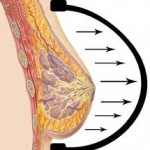
While it is understandably appealing to many women to consider a natural method of breast augmentation using their own fat, the rate limiting step is fat availability. Many young breast augmentation patients, besides having little breast tissue, also have little body fat. Similar to buttock augmentation with fat (Brazilian Butt Lift), one has to have a certain amount of fat to be harvested, processed and then concentrated for injection. This also eliminates most patients who have had prior liposuction of their fat areas. How much fat is needed? In general the harvest to fat injection volume ratio is about 3:1. So, for example, if one needs 200cc per breast for injection, one has to have enough fat to result in a 1200 cc liposuction harvest. That is a severe limiting factor for many patients.

Another consideration in the FIBE technique is the reality of what can be achieved. You simply can’t go from an A cup to a C or D cup. There is a limit as to how much the breast can be enlarged by fat injection. One should expect about a ½ to one cup size bigger. Besides how much fat is available and how much can be made to survive, there is also the issue of the shape that results. Fat injections tend to make the breast wider rather than give it much projection. This is a function of a soft material (fat) pushing against the underlying chest wall as opposed to a harder material. (implant) With fat the skin pushes back much more than against a more firm saline or silicone gel breast implant.
It can be seen that fat grafting is not a quick fix even if it is a natural enhancement method. The best candidates for FIBE in primary breast augmentation are determined by their emotional and anatomic issues. One needs to have realistic expectations and to know that it is a process. It is not like using an implant where the result is available in one hour of surgery. Anatomically the ideal patient is one that has looser skin due to having had children and has lost breast volume. This doesn’t mean that nulliparous women can’t be done, just that they will likely require more breast tissue expansion and more than one injection session.
While breast augmentations is the most challenging application of fat injections, its use in various breast reconstructions is ‘easier’. This is because there is some existing breast tissue and skin…the breast is already expanded so to speak. There is a wide variety of breast reconstruction applications from tuberous breasts, breast asymmetry, and as an aid in implant reconstructions that have been irradiated. From a cosmetic breast standpoint, the biggest growing indications are in implant replacements and in conjunction with breast lift surgery. For those patients that no longer want their implants due to problems or having developed a more recent failure/deflation of an implant, the implant space can be injected with fat. In breast lift surgery, it is common to need a concurrent implant for persistent upper pole fullness. But many breast reshaping patients only need a small implant and they would be better served with fat injections instead. They have enough breast tissue to be injected into and almost always have enough fat to harvest as they are often older and have had children.
Despite the potential value of fat injections in the breast, there is also the consideration of how it impacts breast cancer detection. Patients need to have a mammogram before fat injections and should not have a significant family history of breast cancer.
Dr. Barry Eppley
Indianapolis, Indiana


